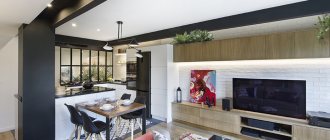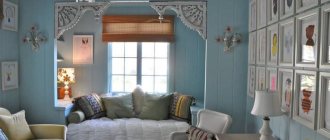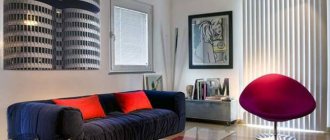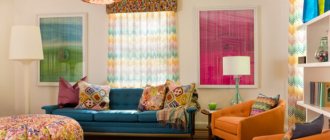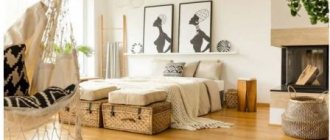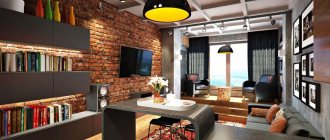Interiors in historical styles always attract attention. A room in the Gothic style is a wonderful confirmation that elegant and majestic Gothic can be organically embodied in the interior design of a modern apartment. To do this, of course, you should follow some recommendations. But first, let's look at the features of the Gothic style.
Gothic style in the interior is elegant and noble materials and furniture, reaching towards the ceiling
Features of Gothic interior styling
The Gothic style of the interior has a kind of mysticism - stained glass windows, striking in their multicolored colors, on the huge windows, pointed vaults. The main distinctive feature of the style is vertical elements, there are many of them, as if the entire space is rushing upward, due to which severity and majesty are achieved. Among other important elements that distinguish the interior in the Gothic style:
- very large windows;
- abundance of light;
- complex forms of vaults.
Gothic style combines aristocratic elegance with sophistication and grandeur. Since the Middle Ages, the style has undergone many changes, it received a new life in the 19th-20th centuries, but even now its features can be seen in the interior design of expensive restaurants, hotels and some country houses.
The style will allow you to create a uniquely unique interior, but it is unlikely to be suitable for small-sized “Khrushchev” buildings and panel high-rise buildings - Gothic style requires space, height and an abundance of light.
And in a country mansion or apartment there is an opportunity to expand, but even here you should not reproduce the Gothic interior in its original form - it can turn out to be a mystically gloomy room. Give preference to stylization in the Gothic spirit, choosing the main features to emphasize the luxury of the interior.
When did the Gothic style appear?
This trend in architecture appeared in the 13th century, when only wealthy feudal lords could afford houses and mansions in the Gothic style. This architectural solution has never been accessible to the lower and low-income segments of the population. The high ceilings and monumental appearance of the buildings required a special design corresponding to the status of crowned heads and noble nobles.
One of the justifications for the height of buildings in the Gothic style is the desire of medieval man for God.
Luxurious and majestic buildings took centuries to build, an example of this is the famous Notre Dame de Paris Cathedral, which took two centuries to create. The Roman cathedral broke a record, because it took three hundred years to build, and it reached a height of about eighty meters.
The style came to the interior from architecture and initially caused only negative reviews. For example, cultural figures of the Italian Renaissance, including the great Raphael, spoke of him in a derogatory manner, calling him barbaric and devoid of aesthetics.
The term "Gothic" comes from Latin and, in relation to architecture, means "frighteningly majestic." It was used in relation to barbarians and ignoramuses who do not understand architecture. During the Renaissance, artists began to use the term to express the majesty and massiveness of structures that had a terrifying appearance and non-standard proportions. After the decline in the popularity of the Romanesque style, Gothic gained widespread popularity.
Together with Victorian interiors, the "barbarian style" became popular again in the 18th and 19th centuries. The development of construction made it possible to create taller and “lighter” buildings.
Characteristic features of the style
Initially shrouded in mystical ideas, the Gothic style has very specific characteristics.
These include:
- stained glass and stained glass panels on the windows;
- complex pointed vaults;
- vertical elements;
- large windows creating an abundance of light;
- frescoes;
- carved facades made of valuable wood;
- antique and exclusive furniture and decorative details;
- a combination of noble colors and delicate elements;
- stairs;
- arches, beams, niches;
- forged lamps.
The presence of all these features in interior design is not strictly necessary; it is important to maintain a balance in the combination of elements.
Modern gothic interior
First of all, the Gothic style in the interior is space and a lot of light. Therefore, it is better to choose spacious rooms with high ceilings for styling. If you initially planned to design a cottage in the Gothic style, pay attention to the windows - they should be high, ending at the top with an arch with pointed points. The shape of the windows is elongated, vertical.
For interior decoration, only natural materials are proposed, among which three should be given preference:
- a natural stone;
- tree;
- metal.
Plastic and artificial materials are not for the Gothic. Leave them to modernity, and here marble and expensive types of wood will be appropriate - for furniture that will be decorated with carvings. It can be decorated with gilding, because the main thing in a Gothic interior is chic and luxury.
The correct choice of materials and distribution of all decorative elements will create a living room in the style of medieval castles, and a bedroom in the style of royal chambers.
History of appearance
Legend has it that when the Pope asked Raphael in the 13th century how the construction of St. Peter's Basilica was progressing, he responded by dismissively calling the building “Gothic”: barbaric, devoid of true aesthetics. The famous master did not even suspect that he had given the name to one of the greatest styles in the history of mankind.
Initially (XII-XV centuries) the style existed exclusively in architecture. The Gothic style in the interior appeared much later, in the era of historicism (late 19th century). At this time, the nobility of Great Britain, Germany and other European countries were carried away by the fashion for building estates in the neo-Gothic style.
Gothic style originated in the middle of the 12th century in northern France. The first Gothic building appeared in Paris. In 1136-1140, Abbot Sugeria erected two spans of the main nave of the church of the Abbey of Saint-Denis. The abbot believed that the temple was a ship symbolizing the Universe. Light marble columns resemble masts directed upward, and smooth lines under the arches resemble sails stretched by the wind.
Gothic style finishing options
Gothic design is not simple; you will have to make an effort and use your imagination to recreate it in an ordinary modern apartment or private house. But you can get acquainted with a lot of examples of successful implementation, get inspired by them and get down to business.
And we’ll give you a few ideas and talk about what you should pay attention to when thinking through the layout.
- Walls. If you want to be completely immersed in historical realities, then draping the walls with fabrics, such as velvet or cloth, would be a good option. Of course, this is not the most practical solution, since it will not be cheap, and the coating will get dirty, absorb moisture and collect dust. A compromise could be regular painting or pasting with textured wallpaper with floral patterns.
To give the setting more of a late medieval look, decorate the walls with trellises or carpets with a themed pattern. But familiar paintings are rarely used.
A room in a Gothic style is often zoned using different wall decorations. For example, decorate the corner of the living room where you are going to leisurely drink coffee at the table in calm tones, create an imitation of brickwork around the fireplace, and let the place for receiving guests be more lively and colorful.
- Ceiling. It’s unlikely that anyone today pays attention to ceilings - they are the same almost everywhere. But to create a Gothic interior you will have to try hard - ordinary whitewash, simple tension and hanging options will not work here. Complex designs, reminiscent of an open umbrella, with stucco molding and paintings are not always available in the apartment, but it is quite possible to create a spectacular stylization. Thematic prints, decorative arches, open beams will come to the rescue.
- Floor. Antique or antique. No simple laminates! Complex ornate patterns of artistic parquet or mosaic ceramic tiles are the most suitable options. It is advisable to choose finishing materials in dark colors - this is a tribute to history, since during the heyday of the Gothic style it was problematic to care for light-colored floorboards.
Carpets and runners are appropriate in the interior, which, on the one hand, will emphasize the luxury of the home, and, on the other, will soften the severity and pretentiousness of the decor.
Second life of the Gothic style: neo-Gothic
During the era of historicism in the 40s of the 18th century, interest in Gothic revived in Great Britain. Neo-Gothic became the “official” national style of Great Britain thanks to an expert and enthusiast of this movement, Augustus Pugin. He rebuilt the British Parliament building that burned down in 1834.
In the United States, the first building in the neo-Gothic style was Trinity Church.
Gradually, a substyle of collegiate Gothic, characteristic of college campuses, emerged from the neo-Gothic here.
Neo-Gothic style also spread to Germany, where, after the revolution of 1848-1849, medieval architectural monuments such as Cologne Cathedral were actively revived.
In parallel with the restoration of ancient Gothic cathedrals, the construction of secular buildings in the neo-Gothic style took place.
A striking example is the town hall buildings in Munich and Berlin, the unique complex of Hamburg shipyards - Speicherstadt.
In France and Italy, neo-Gothic was perceived rather as a call to restore and preserve medieval buildings in the Gothic style.
Thus, in Paris, after the publication of Victor Hugo’s novel “Notre Dame Cathedral,” the mentioned cathedral became the object of attention of residents, and in Italy, the most ambitious project of the neo-Gothic movement was the construction of the façade of the Cathedral of Santa Maria del Fiore in Florence.
One of the key moments in the development of neo-Gothic was the appearance of the Gothic style in the interior.
In 1795, William Beckford began construction of the imposing Fonthill Abbey estate in Wiltshire, with an octagonal 90-meter tower.
The tower collapsed three times within 30 years, but Beckford's estate still made an indelible impression on his contemporaries.
The European nobility eagerly picked up this idea and began building their estates in the same style. At the same time, the basic principles of medieval architecture were preserved when designing buildings, and the interior was supposed to create the feeling that you were in a knight's castle.
Choice of colors
Gothic style in the interior involves the use of rich dark shades. The choice of color scheme depends on the individual preferences of the residents.
Gothic is usually associated with deep shades of dark colors. Gothic style in the interior of public places allows for the preservation of the basic characteristics, but a predominantly dark interior is not very suitable for decorating a living space.
A gloomy design will have a oppressive effect and compress the space, which is very difficult to be in all the time.
- With the help of a variety of materials used to decorate certain parts of the room, you can divide the room into functional zones.
- It is acceptable to use a neutral color scheme for the main decoration of a living space, which can be complemented with decor typical of a Gothic interior.
- Mixing Gothic with other styles allows you to create a cozy and comfortable environment in a living space. Typical apartment layouts are mainly suitable for the partial use of basic Gothic elements.
Gothic style color palette
Color is important for Gothic interiors. To create a room that is close to the historical stylization, light shades are chosen as the main tone: white, beige, milky. They will allow the room, which uses the typical Gothic color scheme, not to look gloomy:
- cherry;
- ruby;
- purple;
- grey;
- Navy blue;
- blue-black tones.
Without a light background, the room would look gloomy and dull. Multi-colored stained glass windows play especially brightly on it, in which a variety of colors can be used: red, brown, yellow, blue.
Gold and silver threads are allowed in stained glass windows, as well as in the decoration of furniture, decorative items, wooden or stone carved elements.
Gothic style in the interior of the apartment
Apartment design in Gothic style
See also: DIY plasterboard arches for the hall: photos and detailed instructions
Furniture selection
Solid wooden furniture in the Gothic style is suitable for decorating both spacious and small rooms.
In the living room you can place massive chairs, stools, cabinets, tables. Natural material may not be painted; decorative carvings are welcome. The interior of the bedroom can be complemented by a four-poster bed; the headboard should also be massive.
Wooden elements in the interior can be replaced with forged ones. Tables and chairs with forged legs will emphasize the luxury and elegance of the original stylistic direction.
Unusual models of sideboards and cabinets with large, high legs will complement the interior of the living room. Cabinet doors or kitchen facades can be decorated with stained glass windows. Individual decorative elements adorning furniture can be coated with gold or silver paint.
The presence of original secret structures, for example, boxes, caskets, chests, is welcome.
You can complete the stylization of the Gothic interior with the help of marble elements, for example, countertops, large mirrors, and finishing the fireplace with natural stone or marble.
Gothic style furniture
If everything in a Gothic interior tends upward, then furniture even more so. It should be high:
- double-leaf tall cabinets;
- buffets for dishes with high legs;
- massive beds with high headboards;
- chairs with soft upholstery and high backs.
The table is massive, with a drawer protruding forward. Solid, luxurious furniture is made of dark wood, it can be decorated with carvings and complemented with forged fittings. Cabinet doors in the living room and kitchen can be decorated with stained glass inserts. Often cabinets are decorated with a “Gothic rose”, thereby emphasizing the stylization of the interior. Dark carved elements of cabinets, beds, tables can be coated with gold and silver paint.
Important! Any furniture in the Gothic style should have its secrets - secret drawers, caskets, chests.
Gothic style in interior design
Room interior in Gothic style
Unusual apartment design in Gothic style
In the living room, chairs reminiscent of a royal throne with high backs and armrests, round tables with carved legs are appropriate. They will be complemented by marble countertops and mirrors framed by a massive frame. A mandatory element of the living room is a fireplace with a metal grate in a wooden frame. Ideally, it will be decorated with Gothic ornaments and Celtic symbols. The fireplace can be decorated with natural stone, marble, for example.
The bedroom should have a wide bed with carved columns and a canopy or a forged one with a high headboard. Here you can also place a mirror, a table, a tall wardrobe. A wooden chest with forged elements and a wicker rocking chair will complete the styling.
Important! You should not oversaturate the interior, trying to fit all the elements of style into it. Choose several - otherwise, instead of a luxurious one, you can end up with a gloomy house that evokes despondency.
Gothic style in the interior of the apartment
Apartment design in Gothic style
See alsoEcostyle in the interior: history, photos, tips
Bright colors of the new Gothic
The Middle Ages is not only about gloomy, dark tones, but also pure, rich colors. Therefore, a modern interpretation of Gothic in the interior allows for the active use of bright shades of yellow, red, and blue.
The Gothic style likes to emphasize the richness of the decoration with gold and silver subtle patterns. For contrast, add purple or ruby, green or emerald tones.
Details and decor
A Gothic style interior is characterized by a minimal amount of decorative elements and decorations. The main decoration in the room should be a large fireplace, decorated with natural stone and forged metal elements.
Also, frescoes and stucco moldings, wall tapestries with heraldic themes will look great in Gothic.
The following are most often used as decor in the Gothic style:
- Large, massive mirrors in wooden or metal frames.
- Ancient weapons on the wall, forged candlesticks.
- Bronze or gilded cups, plates, vases with carved patterns.
- Unusual sculptures made of wood or metal, torch-shaped lamps on the walls.
- Paintings with historical themes - images of knights or knightly fights.
- Colorful textiles from which massive, heavy draperies are made.
The Gothic style in the interior is a unique combination of luxury and mysticism, which will definitely appeal to all fans of originality and creativity.
Characteristics and features of the Gothic style
Of all the known styles for interior decoration, the Gothic style is one of the most interesting and unique. It began in the Middle Ages during the reign of Queen Victoria in Great Britain. There is an opinion that this style is gloomy and suitable only for closed people. It is completely wrong, because Gothic in the interior is elegance, aristocracy and a rich color palette.
The clear outlines of this design style were formed in Europe during the period of the 12th-15th centuries, which was preceded by revolutionary changes in religious trends, art and socio-political foundations. Even now you can see the majestic works of architects of those times in the form of ancient castles in Western Europe. Gothic perfectly emphasizes status and combines:
- severity;
- restraint;
- wealth of shapes, colors;
- a large amount of decor.
Over the long period of its existence, the Gothic style in the interior has undergone various changes and has come to our time in an updated form. So it has more light shades, which makes it possible to make more varied designs.
He has also adapted to city apartments and small country cottages, despite the fact that he loves a lot of space. Modern hotels, hotels and restaurants often use this style to decorate their halls and rooms so that guests can immerse themselves in the era of the knights.
Gothic in the interior is a highly aesthetic style; only natural materials (wood, marble, glass, animal furs) are used in its work. They allow you to convey the spirit of the Victorian era and create a unique atmosphere in the house. Features of the Gothic style are:
- Color spectrum. The Middle Ages period is shrouded in secrets and mysticism, so dark shades are characteristic of the style: brown, burgundy, black, blue, dark green, purple, violet.
- Stained glass. This type of decorative and applied art already in the Middle Ages was considered a sign of wealth and influence in society. Stained glass was used mainly to decorate windows, large and arched. In a modern interpretation of the Gothic style, they are appropriate on glass inserts of interior doors, cabinets, and wall panels.
- Enhanced lighting. The Gothic color palette is usually dark, so a lot of light is required to highlight all the advantages of the interior. Traditionally, this is a large forged chandelier and, if necessary, wall lamps made in the same style.
- Comfortable furniture. Furnished design items should not only be made from natural materials, but also provide comfort. That is why tables, chairs, sofas are massive and quite large and rough, but not without artistic carving and forging on protruding backs, armrests and other parts.
- Abundant decor. Gothic style is favorably emphasized with curtains made of thick fabric, forged lamps, glass vases and metal dishes, tapestries with historical images, paintings and objects of knightly valor.
In the Gothic style there are many patterns on the walls, curtains, and upholstery. Large mirrors in massive frames with decorative designs beneficially expand the space, emphasizing the symmetry of the design. By decorating windows with stained glass, you can create an interesting play of light in the room. Such special lighting can in no way make the interior gloomy or boring.
Modern Gothic interior decor
- In order not to oversaturate the interior with details characteristic of the Gothic style, you should not get carried away with numerous decorations. Balance the space.
- If the windows are decorated with stained glass, curtains are not needed. However, you can decorate interior doors and furniture facades with stained glass, then decorate the windows with thick, heavy curtains on forged or massive wooden cornices.
- Plain walls can be complemented with tapestries or tapestries - Gothic paintings are not acceptable. The subjects of tapestries are best found in medieval themes - knights, castles.
- Upholstery of upholstered furniture - expensive fabrics: brocade, velvet. It is better to choose a dark color scheme - burgundy, dark blue, with a jacquard pattern or a smooth structure.
- The “Gothic rose” in itself is already a means of stylization, and its placement on the fronts of cabinets and on the fireplace is a decorative element.
Pretentious and sophisticated objects would be appropriate in a Gothic living room - everything should emphasize the high status of the owners: stone sculptures, figures carved from wood or ivory, metal figurines, forged furniture elements, massive candlesticks.
Gothic interiors pay a lot of attention to light - a massive steel chandelier on low pendants, decorated with forged candlesticks, will complete the stylization. It is hung in the center of a high, spacious living room and can be complemented with pendant lamps and wall sconces.
The main task of choosing a Gothic style for the interior is to create the atmosphere of a rich medieval castle.
Considering that in a modern home it is difficult to achieve complete stylistic consistency, it is better to choose only a few elements characteristic of Gothic. They will create the effect of luxury without overloading the space.
Lighting
The highlight of the Gothic style is a huge metal chandelier under the ceiling. Of course, earlier light bulbs were replaced by candles, but even today there are lighting fixtures in the form of candles. Such a chandelier should have chains or forged parts. Its color can be either dark or light. Modern lighting options add glass decorations.
Antique candelabra with ornate candlesticks are a good way to add solemnity to the appearance of your home. Simple floor lamps and lamps are not used here. Everything should be stylized in the castle style of the Middle Ages.
If it is intended to use lighting fixtures that do not fit into the overall composition, they are decorated to resemble more antique items.
Through the prism of lighting, you can also consider the use of the Gothic rose. Nowadays, designers advise reproducing a stained glass window with a rose not only on glass, but also using this image to imitate false windows, behind which you can hide various lighting elements.
Wall variations of lamps are mainly used when decorating fast food restaurants or establishments for high-profile audiences. Since you can’t do without wall lighting there.
Buildings of recent decades are not entirely suitable for the use of Gothic design. But its elements can be used both in enterprises and in residential premises.
For example, Sandra Bullock's mansion is entirely made in the Gothic style. And Nikas Safronov’s apartment “absorbed” his best components.
Modern neo-Gothic is also subject to change, like other interior trends. The age of technology dictates its own rules. And not taking them into account means giving up increased comfort and convenience. When creating a Gothic interior, you should not focus too much on the authenticity of things and accessories. It's better to pay attention to the overall concept. Because it is she who creates the right atmosphere.
Currently, designers rarely receive orders for decoration in the neo-Gothic style. Living in your own little castle requires a special state of mind. But if a person is a fan of the heyday of the style, then he will be able to bring to life a Gothic idea so that it fits perfectly into the chosen room. Gothic is a movement that can be compared to art.
Living room
The living room is the face of the entire apartment, this is the place where meetings with guests or loved ones take place. An integral part of this room is the fireplace; its unusual decorations in the form of Gothic ornaments or Celtic symbols are an additional decoration of the entire room. In this room it is customary to install round massive tables made of wood with long carved legs.
Chairs or armchairs with high backs in the form of a throne. To serve tea to guests, there must be a bulky set of tea in the living room.
Bedroom
In the bedroom, the main piece of furniture is the bed, and in a bedroom made in the Gothic style its importance increases. A large massive bed must have columns on which a canopy or curtains made of thick fabric are attached. To store things, you can install a chest framed with carved patterns and forged parts.
Hang a mirror in a wooden frame on the wall, and choose a table with a marble finish. The chair is comfortable, soft and fit for a queen, and for reading you can select a separate area with a wrought-iron lamp on a long leg and a rocking chair.
Kitchen
A Gothic style kitchen is a spacious room. It is better to make the windows and the opening into it in the form of an arch and decorate them with stained glass and doors. When choosing furniture, you should give preference to wood, choose a dark or even black color. Place kitchen cabinets, both wall-mounted and floor-mounted, along the wall.
Modern new items fit perfectly into the Gothic style, and if desired, they can be disguised with wood or stained glass.
On the floor you can put ceramic tiles with interesting plant patterns or an expensive wooden board. For lighting in the kitchen, a chandelier is usually used, suspended from the ceiling using a chain. It is better if it is forged and with lamps in the form of candles. An unusual element in the kitchen will be a forged candlestick in the shape of a dragon.
It will add some mystery or romance. Some of the walls are decorated in the form of artificially aged stonework. The other part of the wall can be covered with wallpaper with Gothic designs or ornaments.
Children's room
It is better to make a room for a teenager in a Gothic style in rich, bright colors. Cover the walls with light wallpaper, and create color accents when choosing furniture. Hang curtains made of thick fabric on the windows; they will protect the child well from the sun's rays on a weekend and allow you to relax and prepare for the next school week.
The bed, as in an adult bedroom, can be with a canopy, with high carved headboards.
Choose a desk made of wood and install it near shelves for books and school supplies. You can also install a small table and a sofa in a teenager’s room, on which the child will enjoy reading. A sconce in the form of a wall torch will look impressive on the wall.
Design features
Gothic style welcomes the hand-made nature of interior items, the dominance of exclusive finishing materials - fabric wallpaper, wooden parquet made of juniper, oak or larch, stairs with monumental stone or metal railings, beveled tiles that fill the house with cold reflections.
Most furnishing details must be made to order or selectively selected by interior designers:
- A massive bed with columns and a canopy, a dressing table with a wrought-iron base and a large mirror decorated with a metal baguette with characteristic heraldic motifs are ideal for furnishing a bedroom;
- to create an expressive accent in the living room, it is worth installing a monumental fireplace with an iron, plaster with painting or stone portal decorated with Celtic ornaments;
- to decorate the kitchen, you should choose a large room that provides for the creation of spacious areas for cooking and dining, where it is important to install a set with a marble countertop, a massive oak table surrounded by high-backed chairs with an iron frame;
- to organize lighting in your home, you need to use multi-tiered chandeliers, decorated with metal pendants, glass inserts with stained glass paintings, floor lamps and sconces that imitate the image of antique chandeliers with patterned branches and a cluster of candle stands;
- To create window decorations, you should use elite fabrics and eyelets made of valuable metals. They should organically resonate with furniture frames, upholstery, bedspreads, carpets, shiny tapestry pillowcases and other textile items.
Advice! To save money on the implementation of a design project in the Gothic style, it is worth using rare items from the collection of family heirlooms.
In addition, you can restore old furniture, giving it antique features through deliberately rough finishing and wrought iron. Having mastered the basics of stencil painting of walls, you can add a personal touch to the cladding of your home. Hand-made decor looks contrasting against the background of factory interior details.

